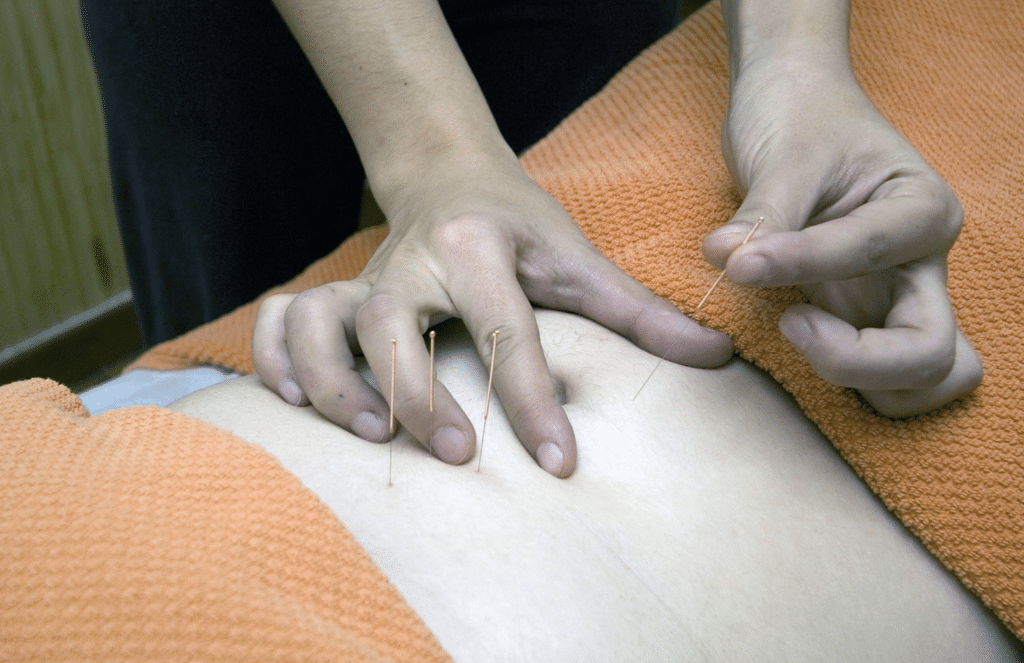
Humanity has a long history of coping with pain and immobility, and one pain and mobility coping tool that more people are turning to is called dry needling. Employed by some physical therapists, sports injury therapists, and massage therapists for the treatment of muscle pain, dry needling is a novel treatment based on an ancient design. We were wondering; what does dry needling do?
What Does Dry Needling Do?
Dry needling uses thin needles, much like acupuncture needles, to penetrate the skin and muscle. The goals of dry needling are to stimulate trigger points in the muscle to relieve tension or to stimulate the areas next to painful areas to reduce pain.
As a very new treatment practice, there is limited evidence about the question of what does dry needling do, how it works, or how effective it is.
If you are as intrigued as we were about using needle insertion to reduce pain and increase movement, read on for some interesting facts about dry needling. We explored the different techniques of dry needling, the benefits, and risks, who practices dry needling and who it may benefit, how it differs from acupuncture, and what research is available to support dry needling.
Dry Needling Books to check on Amazon
No products found.
The Techniques Of Dry Needling
Practitioners with quality training in dry needling will use some standardized techniques that you can watch for. They will wear gloves and other personal protective equipment to prevent exposure to bodily fluids and prevent the transmission of disease.
They will use new, sterile equipment for each person, and they will safely dispose of used gloves, personal protective equipment and needles immediately after each treatment. The practice of dry needling is relatively straightforward.
The practitioner inserts very thin, stainless steel needles through the skin and into the muscle tissue and surrounding myofascial tissue, which is why dry needling is also called intramuscular stimulation.
These needles, called filiform needles, are so small in diameter they can appear as thin as hair. The needles are absent of any medication on or in them, which is why they are called‘dry.’
Trigger Point Needling
The needles are not randomly placed. They are most often directed at trigger points which are hard, knotted areas of the muscle and fascia and are placed in the trigger point and left in place for a few minutes. Trigger points are hard bands of knotted muscles and fascia which are painful to the touch and may cause pain to radiate to other parts of the body.
Sparrow Pecking
Sparrow pecking is when the practitioner inserts the needle and removes it immediately. This technique is also called pistoning, or in-and-out, because the needle goes in and comes out again. Sometimes this is done repeatedly over one small area or a more generalized area.
Non-Trigger Point Needling
Non-trigger point needling rests on the idea that pain is not localized but travels to the more extensive central nervous system. With non-trigger point needling, the practitioner inserts needles over a larger area, usually surrounding the area of acute pain. By stimulating the nerve pathways adjacent to the area of pain, practitioners believe the pain will be reduced.
Benefits Of Dry Needling
By asking “what does dry needling do,” most people want to know how it benefits the body. Dry needling can stimulate tense bands of muscles and trigger points.
By stimulating the trigger point of a tight muscle, the needle can cause that muscle to relax and release. The idea of encouraging this relaxation is to improve movement, flexibility, and range of motion, as well as reduce pain and stiffness.
It can also help stop or reduce muscle spasms. All of these benefits have the effect of giving relief from pain and greater mobility, leading to a better quality of life and return to normal activities.
Risks Of Dry Needling
People report different sensations when dry needling is done from feeling nothing at all to a tickle, twitch, cramp, or prick. Severe pain should never be a reaction to dry needling. Severe side effects, in general, are unlikely and uncommon. However, there is a risk of contracting blood-borne infection, such as HIV and hepatitis, if non-sterile needles are used; so ensure your practitioner opens a new pack of sterile needles at each visit. Common side effects are the effects of the needle entering the skin, including bruising, bleeding, or soreness at the site of entry.
Dry Needling Vs. Acupuncture
Many people believe that dry needling and acupuncture are synonymous. They both use filiform needles to pierce the skin to relieve pain. However dry needling is not acupuncture; ask an acupuncturist!
Acupuncture is an ancient medicine tool which works with paths of chi, or vital energy. Blockages in chi can result in pain, disorder, and disease. In acupuncture, the main goal is to open these pathways and allow the body’s vital energy to flow smoothly, thereby reducing pain and muscle tension. Acupuncture requires extensive training and certification and is regulated in all of the United States. It has extensive scientific evidence supporting its safety and effectiveness.
Dry needling, on the other hand, works directly and physically on the tight muscles on myofascial tissue itself. It does not require knowledge of Oriental medicine or belief in the chi energy pathways of the body. Dry needling is not regulated or licensed and can be done by anyone, although if considering dry needling, we recommend you are careful with your practitioner choice. Evidence for dry needling is limited and just developing.
Users And Practitioners Of Dry Needling
Individuals with any type of pain and muscle impairments may appreciate dry needling. It is explicitly designed to treat pain, and mainly pain with its origin in muscle damage or damage of the nerve pathways.
People with sports injuries, chronic muscle pain, herniated discs, fibromyalgia, arthritis, muscular strain, nerve irritation, and ligament strains are some examples of the people who find benefit from dry needling.
Training programs for dry needling are inconsistent although physical therapists, massage therapists, and sports injury therapists sometimes receive training in dry needling through school. Others learn dry needling after they have been in practice for a while. It is usually an alternative training option, and there is no guarantee that your therapist knows this technique.
There are few regulations or licensures, and there are no credentialing or regulatory boards for dry needling. Most of the time, a licensed physical therapist the person who will recommend dry needling; and will possibly have the most training in it.
As we stated above, choosing your practitioner with care is very important. We recommend you choose someone with extensive education on the normal anatomy of the human body, muscular and skeletal system. You may want to ask the practitioner what their original training is in and where they learned to perform dry needling.
Experience matters as well, so choose a practitioner who has practiced dry needling long enough to to be able to answer your question of “what does dry needling do” and tell you how to make it most effective. If your practitioner is new to dry needling, ask if their mentor can observe and offer insight into the technique.
The Evidence For Dry Needling
There is very little evidence to support or discourage dry needling. Unlike acupuncture, which has existed for thousands of years and has some strong evidence for its effectiveness, dry needling practices are only a couple of decades old and research is limited. Some research has been done and more is occurring.
Dry needling has some research to support its use in treating mild to moderate pain, and some research which says it is no better than a placebo or doing nothing.
There are some studies which show that dry needling improves the control of pain, reduces muscle tension, and heals the dysfunction of nerve pathways that conduct pain.
New studies, although still small, demonstrate that it has few side effects and may be useful. Safe practices are being standardized as the practice, and research on it, continues.
Conclusion
What does dry needling do? Dry needling uses tiny, sterile needles to pierce the skin and enter the fascia and muscle tissue. It uses techniques to target trigger points in the muscle or the tissues surrounding areas of pain and tension. By inserting the needles, pain may be reduced and tension relieved.
There is some evidence that dry needling, performed by a trained and qualified practitioner, may have some significant benefits and carries minimal risk.People who use dry needling often report that it helps relieve muscle pain and tension and allows them to move more freely and easily.
The idea is that by improving movement and reducing pain, the person may return to everyday tasks more quickly and proceed to more active rehabilitation if injured. Dry needling might be something to try if you are experiencing pain and muscle tension, and if you are willing to navigate the uncertainty of this new treatment
Featured Image via Pixabay
Last update on 2023-03-07 at 03:25 / Affiliate links / Images from Amazon Product Advertising API
